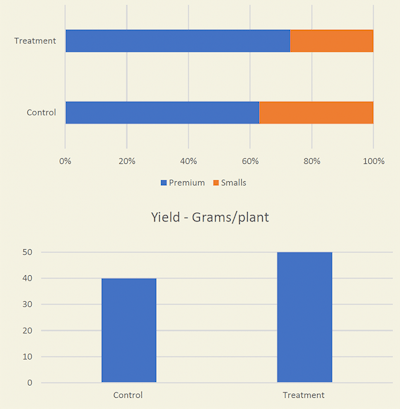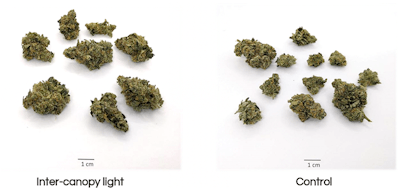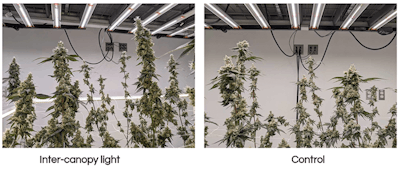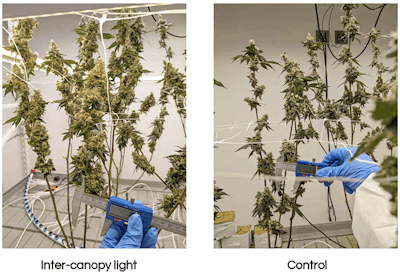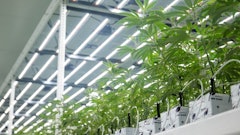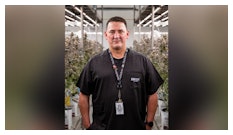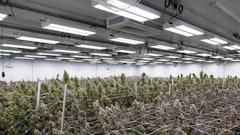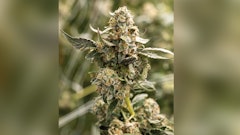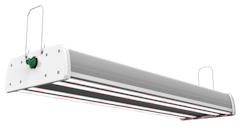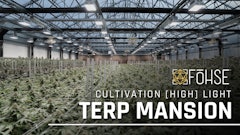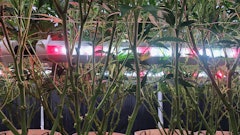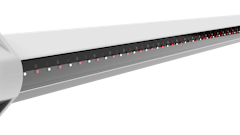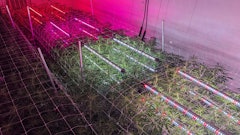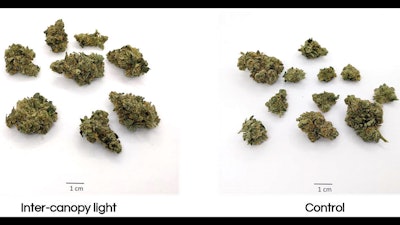
Editor's note: This is the second article in a series about intercanopy lighting in cannabis cultivation. StateHouse Holdings, a vertically integrated cannabis company based in California, led a group that conducted research to determine if applying light directly to all flowers on a single plant, and not just from above, improves photon conversion efficiency, resulting in greater yields produced at lower costs. The first article in the two-part series outlines the scope and purpose of the study, and this article details the results.
Intercanopy lighting has quickly become an emerging technology in recent years with researchers, manufacturers and cultivators alike reporting dramatic increases in yield and quality. Industry surveys report overwhelming interest, including results of State of the Cannabis Lighting Market research published in the October 2022 issue of Cannabis Business Times, where more than 50% of participants indicated interest in intercanopy lighting. Many lighting manufacturers offer intercanopy solutions to meet demand.
StateHouse Holdings decided to explore intercanopy lighting further using Grow Light Design, an intercanopy lighting solution designed to overcome the challenges of incorporating side lighting at scale, to determine how yield and quality would change. After the California cultivation company realized significant increases in yield and ratios of large to small bud, the question that still remained was, “Is the increase in yield due to additional light and energy being applied or is the difference due to the position of the light in relation to the plant?”
To help answer this question, Travis Higginbotham of StateHouse Holdings formed an Intercanopy Validation Group to determine the impact of redistributing a fixed portion of light directly to the sides of cannabis flowering plants when adding no additional light.
The objective of the study was to determine the impact of redistributing the same DLI (same amount of energy used) between top lighting alone vs. the combined application of top lighting plus the surround canopy fixture
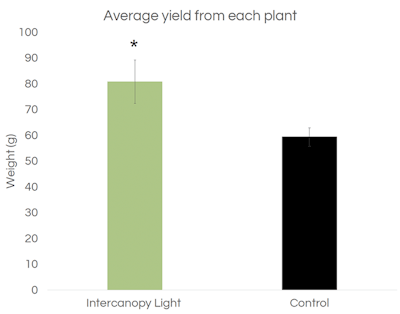
RELATED: Can Intercanopy Lighting Improve Cannabis Yield and Quality?
This group also includes the Cannabis Research Coalition (CRC), led by Dr. Allison Justice, founder and CEO of The Hemp Mine; a global cannabis producer that wished to remain anonymous; and the company supplying the technology, Grow Light Design. StateHouse, CRC and the global cannabis producer participated in the study in separate indoor cultivation facilities but using the same methodology. The study ran from June through September 2023.
It was hypothesized that redistribution alone would facilitate higher yields with no additional energy use. These higher yields, if achieved, would carry a higher photon conversion efficiency (g/mole/m2/cycle) and higher energy use efficiency (g/kWh/cycle), therefore increasing yields alongside reducing energy cost per pound.
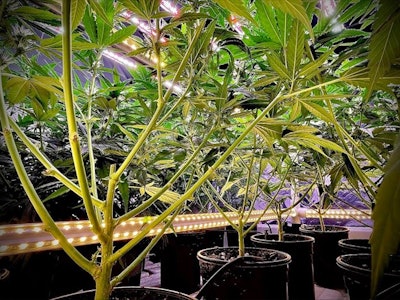
Intercanopy lighting study. Photo by Dr. Allison Justice, Cannabis Research Coalition.
Details and Findings
The study was conducted in each of the three participants’ indoor cultivation facilities. The experiment contained two treatments, treatment #1 (T#1) used top lighting alone and treatment #2 (T#2) was paired with top lighting and intercanopy combined. Each treatment applied the same DLI with T#2, allocating approximately 30% of the total DLI on average, between collaborators, to the intercanopy lighting. Each group included two cultivars and randomized the cultivars throughout both treatments. Each group had differing DLIs, differing cultivars, differing environments, differing flowering times, differing nutrient regimes and differing top lights. Each used the same intercanopy fixtures and the same lighting application principles.
The results, detailed in charts below, showed T#2 had on average a 20% increase in flower yield alongside a 27% increase in premium-to-small flower ratio. Participants also noted a more uniform plant height, which was slightly shorter on average. No significant change in potency was reported.
Conclusions and Recommendations:
Research demonstrated that redistributing a portion of top lighting directly to the sides of the plants can facilitate higher yields with no additional energy use needed. Further exploration of strategies to maximize the distribution of light to all available surface areas is recommended for growers operating controlled cannabis cultivation environments. Each participant in the Intercanopy Validation Group observed a significant increase in production with less energy use. These higher yields also carry a higher photon conversion efficiency (g/mole/m2/cycle) and higher energy use efficiency (g/kWh/cycle), therefore increasing yields alongside reducing energy cost per pound.
The future of cultivation optimization is undoubtedly bright with continued trialing of this and other revolutionary approaches, which have the potential to improve sustainability and lower costs of production.
CHART: Premium to Small Comparison
Data and charts represent average of three studies; all provided by Travis Higginbotham unless otherwise noted.
